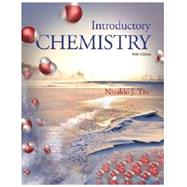Now in its fifth edition, Introductory Chemistry continues to foster deep engagement in the course by showing how chemistry manifests in your daily life. Author Nivaldo Tro draws upon his classroom experience as an award-winning instructor to extend chemistry from the laboratory to your world, with relevant applications and a captivating writing style. Closely integrated with the fifth edition of Introductory Chemistry, MasteringChemistry® gives you the tools you need to succeed in this course.
This program provides you a better learning experience. It will help you to:
• Personalize learning with MasteringChemistry®: This data-validated online homework, tutorial, and assessment program helps you quickly master concepts, and enables instructors to provide timely intervention when necessary.Note: If you are purchasing the standalone text or electronic version, MasteringChemistry does not come automatically packaged with the text. To purchase MasteringChemistry please visit: www.masteringchemistry.com or you can purchase a package of the physical text + MasteringChemistry by searching for 9780321910073 / 0321910079. MasteringChemistry is not a self-paced technology and should only be purchased when required by an instructor.
• Achieve deep conceptual understanding: Several new Conceptual Checkpoints and Self- Assessment Quizzes help you better grasp key concepts.
• Develop problem-solving skills: A step-by-step framework encourages you to think logically rather than simply memorize formulas. Additional worked examples, enhanced with audio and video, reinforce challenging problems.
• Maintain interest in chemistry: The inclusion of concrete examples of key ideas throughout the program keeps you engaged in the material.








